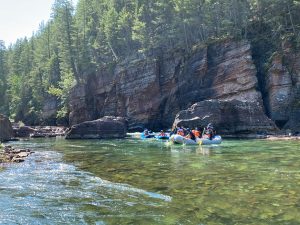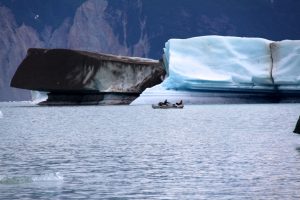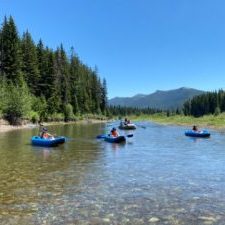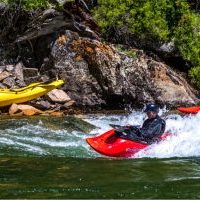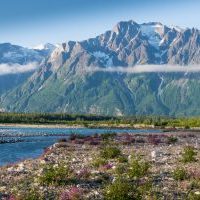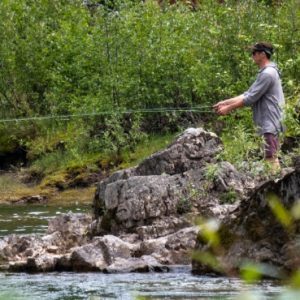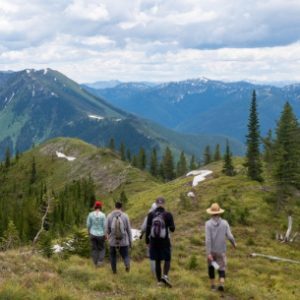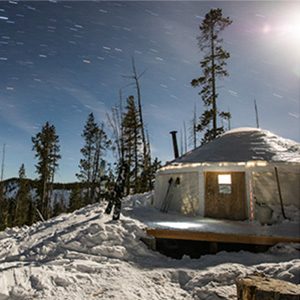A Chance to Save Idaho’s Salmon and Revitalize the Northwest
March 17, 2021
By: Jonas Seiler
Most folks that have done a river trip on the Salmon River have heard the plight of the stream’s native salmon and steelhead. For those that have yet to do a trip, you may be disappointed to hear that the river’s namesake fish are at risk of extinction. Fortunately, there is hope for this iconic species.
WRO’s trips on the Middle Fork of the Salmon, Main Salmon, and Lower Canyons of the Salmon offer an opportunity to see some of the inland northwest’s most intact salmon habitat. As a whole, the Salmon River basin holds vast reaches of quality habitat for salmon and steelhead. The Middle Fork of the Salmon in particular is home to a wild strain of Chinook Salmon that persists, albeit in low numbers, in the wilds of central Idaho. On our summer and early fall trips in July, August, and September, we are occasionally lucky enough to see some of the fish jumping up Dagger Falls or spawning.
In recent years, the effort to restore salmon and steelhead to abundance in Idaho has been rekindled with interest from the PNW states’ Governors and an Idaho congressman that has proposed removing the 4 lower Snake river dams (LSRD). Before we explain why this recent shift may be our best shot at improving salmon runs and preparing the PNW for a clean energy future, let’s look back at the lifecycle of Idaho’s salmon and the reasons why they are struggling in the first place.
Lifecycle
Idaho Salmon begin their lives as eggs in high mountain streams with cold, clear water. Once they hatch, they spend a year in their natal stream growing to a few inches in length, living a life alongside resident trout. The following spring, they ride the spring flood as far as 900 miles along the Salmon, Snake, and Columbia rivers (past 8 dams and reservoirs) to the Pacific Ocean. Once they have reached salt water, they spend several years growing to adult size. Eventually, they begin their return migration to Idaho, swimming 900 miles upstream through 8 dams and sometimes a full vertical mile. Once they reach their natal streams, the same that they were born in, they spawn and die, starting the cycle over again. Idaho’s streams are largely pristine, providing plenty of habitat to rear young salmon.
Decline
Westward expansion in America in the 20th century brought millions of new residents to the Pacific Northwest. In the name of progress, humans set out to tame the landscape to make natural resources the engine of economic growth in the region. In Washington, Oregon, and Idaho, it seemed that the natural resources were inexhaustible. Heavy logging of old growth forest, large scale mining, commercial fishing, and cheap hydropower from the region’s mighty rivers all brought economic prosperity to the northwest; with a price.
Unfortunately, all of these activities were extremely detrimental to the regions once abundant salmon and steelhead runs. Poorly managed clear cut logging allowed fine sediments to choke gravel-bottomed streams that salmon need to spawn. Mining often leached toxic heavy metals into entire watersheds. Canneries on the larger rivers harvested salmon at an unsustainable rate to feed a growing population. Starting with the completion of Bonneville Dam on the mainstem Columbia in 1937, major hydropower producing dams were built at a steady clip. By 1975, eight major dams stood on the Columbia and Snake rivers between the Pacific Ocean and Idaho’s remaining accessible spawning grounds. Unfortunately, the salmon’s long migration past the dams is the proverbial choke point in the system. Predators, slack water reservoirs, and mortality related directly to dam passage are the biggest killers. It is like a 5 star salmon hotel with no good way to get there. The 4 dams on the lower Snake river have been identified as most detrimental to Idaho’s salmon and steelhead.
Collectively, the impacts of these dams and other industries resulted in precipitous drops in salmon and steelhead populations. When Lewis and Clark passed through the region in 1805-1806, the number of fish returning to Idaho were counted in the millions. In recent years, we are counting Idaho’s wild salmon and steelhead a few thousand at a time.
An Opportunity
In early 2019 at a conference at the Andrus Center in Boise, Idaho Republican Congressman Mike Simpson made it clear that he wanted sustainable runs of salmon back in Idaho. He cited a trip to Marsh Creek; a tributary to the Middle Fork of the Salmon, where he saw a single spawning chinook salmon where there once were thousands. Seeing a salmon spawn after such an incredible journey can be downright emotional. The experience had a powerful effect on him. A few years and over 300 meetings later, Simpson has released a ‘concept’ that intends to save salmon and steelhead by removing the 4 lower Snake dams, while addressing the economic impacts that dam removal would have on nearby communities.
Here is an overview of Mike Simpson’s Plan
[ux_video url=”https://youtu.be/z5_fm7UGsw4″]
Congressman Simpson’s plan is much more than a dam removal concept that will strip local communities of economic opportunity, a rumor which has plagued it since its introduction in early February. In total, Simpson is calling for around $33 billion to be spent as the Northwest’s portion of the Biden administrations upcoming infrastructure bill later this year.
Here in Idaho, salmon and steelhead are a big deal. Not only are they a crucial part of the landscape and an important piece of Idaho’s history and culture, but they drive economic activity in the state. Dam removal is our last best chance to give Idaho’s salmon and steelhead a chance at long term viability.
As mentioned before, Simpson’s concept is much more than dam removal. We recommend that you take a few minutes to read through it at the link above. However, we will outline a few of the things in the bill that struck us as significant.
Energy Replacement
Presently, the dams provide a source of reliable and low carbon source of energy. Although the 4 LSRD generate power, they peak in the spring when energy demand is generally low. The reservoirs behind the dams are relatively small, limiting the amount of ‘stored’ energy and flood control capacity. Simpson is proposing $10 billion to replace and improve the generation, storage, and delivery of affordable and clean energy in the PNW. Sources include solar, wind, small nuclear, and pump storage. Additionally, Simpson proposes major investments in battery storage that would help make these renewable sources more reliable when the sun goes down and the wind doesn’t blow.
Barging and Transportation
The 4 LSRD have provided an effective way to ship goods from the inland northwest along the reservoirs of the Snake and Columbia rivers. Grain has been the primary product. Unfortunately, shipments moving downstream have been declining in recent years. Simpson has proposed $1.5 billion to replace barge transportation on the Snake with rail and truck transport. Additionally, there will be funds to reconfigure grain ports and other barging specific infrastructure along the lower Snake to ensure that they can adapt to new ways of transport. There is also $600 million to rebuild and improve the shipping port at Tri-Cities (Pasco, Kennewick, Richland). While removing the 4 LSRD would eliminate barge transport on the Snake, these investments would ensure that shipping infrastructure and barging remain strong in the PNW as a whole.
Litigation Moratorium
If Simpson’s plan becomes reality, a 35 year litigation moratorium on salmon and steelhead related dam issues would take effect. This would effectively end the ‘Salmon Wars.’ All of those dams would also receive an automatic 35 year license extension as well.
Watershed Improvement
Simpson proposes funding watershed improvement in each of the major river basins within the PNW. The Snake River basin would receive $700 million to restore and improve fish and wildlife habitat. This fund would be managed by ‘Watershed Working Groups’ that would consist of different stakeholders; agriculture, conservationists, tribes, etc. This fund could be used to contract with private or public companies to improve freshwater habitat in the Snake and Salmon basins.
Recreation
Simpson plans to create a “Lower Snake River National Recreation Area” for the public. This proposed area would generate tourism dollars and would allow for various activities including power boating, rafting, kayaking, fishing, and hunting. The plan also allocates tourism development funds for Lewiston/Clarkston and Tri-Cities, which would help those communities to ease their transition to largely tourism based economies.
Congressman Simpson’s plan covers many more aspects of this complicated issue then can be covered here. If you are new to this issue, but have a few minutes, take some time to learn about the basic elements. This is an extremely complex issue, and Rep. Simpson has done his homework to address various concerns. We believe that this plan is our best shot to end the ‘salmon wars’ and to give us a shot at a future filled with abundant salmon runs, clean energy, and abundant economic opportunity. The alternative is extinction, aging infrastructure, and endless litigation. At WRO, we hope that the sight of a wild salmon on one of our river trips will be a common occurrence in the future.
